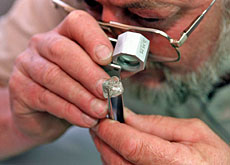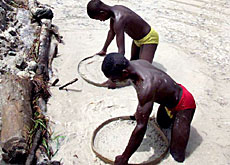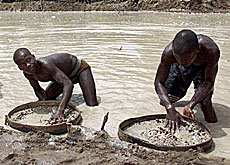Diamond profession considers Kimberley legacy

The Swiss gem and jewellery industry has embraced the Kimberley Process, a global system designed to curb the trade in so-called "blood diamonds", say experts.
But despite the apparent success of the four-year-old agreement, some stakeholders say more could be done to be totally certain of the origins of diamonds.
The film Blood Diamond, starring Leonardo DiCaprio, has once again thrust the issue of conflict diamonds, rough gems whose profits are used to fund conflict in Africa, into the limelight.
In 2006 Switzerland imported 207 kg of diamonds of valued at SFr2.2 billion ($1.8 billion).
Swiss gem expert Ramon Cortes says the Kimberley Process has been embraced by the industry in Switzerland.
“Of course in all professions there are black sheep, but it’s a very good step and we have to continue,” he told swissinfo.
Cortes says there is no problem with blood diamonds in Switzerland – the trade is very professional and diamonds are not cut in the country – but he says it still not possible to be 100 per cent sure about diamonds’ origins.
For him, the problem is the beginning of the process – mining and cutting – which is why he is calling for an industry standard for these early stages.
This would ensure that the stones’ origins could be traced more effectively, he said, and help improve the conditions at mines.
The founder of online diamond store diams.ch, who has visited African mines, is calling on Swiss watchmakers and jeweller companies to lead the way.
Cortes’ proposal is still at a very early stage, but he is confident that many diamond experts think along the same lines. “I think transparency would help us work better,” he said.
Kimberley Process
The Kimberley Process came into force in 2003. The voluntary system requires participants to certify that shipments of rough diamonds are free from conflict diamonds.
In all, 45 participants, including Switzerland, have signed up, accounting for an estimated 99.8% of the global rough diamond trade.
When asked by swissinfo about how the Kimberley Process had affected its members, the Federation of the Swiss Watch Industry said watchmakers only dealt with polished diamonds, and were not directly responsible for the source of the diamonds used.
“When an end user or wholesaler asks, it is up to the manufacturers and suppliers to provide the necessary documents,” said Maurice Altermatt, head of the economic division at the federation.
Altermatt pointed out that the federation, which has raised awareness of the process among its members, had not been told of any problems over the last three to four years.
“Swiss watchmakers pay all requested attention to the supply chain of diamonds in order to provide end-consumers with faultless timepieces,” he told swissinfo.
Ethical charter
For their part, the Swiss Association of Specialised Watch and Jewellery Shops adopted an ethical charter last year covering the principles of the international jewellery business and the Kimberley Process.
According to the French-speaking Le Temps newspaper, only 400 of the 750 members have signed up so far.
Non-governmental organisations, including Amnesty Switzerland, are not convinced enough is being done to prevent blood diamonds entering the country.
In 2004 it carried out a survey in which 33 per cent of Swiss jewellery industry representatives interviewed said they had never asked for guarantees about the origin of diamonds.
While the NGO acknowledges that the Kimberley Process has changed attitudes, it still believes that between one and three per cent of imported or transited diamonds in Switzerland could be suspect.
“Switzerland is not as dirty as it was in 2000 but it still needs to make more effort,” Amnesty Switzerland’s Danièle Gosteli Hauser told Le Temps. “Above all, the level of controls remains insufficient.”
swissinfo, Isobel Leybold-Johnson
Until 2001 Switzerland was the third largest commercial centre for diamonds after Belgium and Britain in western Europe.
But the De Beers company transferred its main activities to London that year, with Switzerland losing is leading role in the rough diamond trade.
According to the State Secretariat for Economic Affairs, the value of imports of rough diamonds remains high and Zurich and Geneva airports play a significant role in the diamond trade.
Conflict diamonds, also known as “blood” diamonds, are rough diamonds used to finance armed conflict, mainly in Africa. They are estimated to represent 2 to 4% of diamonds mined.
Liberia and Ivory Coast are currently subject to United Nations sanctions over diamonds. In Angola, Sierra Leone, the Democratic Republic of Congo, all affected by blood diamonds in the past, the situation remains fragile.
The Kimberley Process, which was drawn up in Interlaken, Switzerland, is an international certification scheme that regulates the trade in rough diamonds. Its aim is to prevent the trade in conflict diamonds, while helping to protect the legitimate trade.
There are 45 participants representing 71 countries (including the 27-member European Union as one participant). All major rough diamond producing, exporting and importing countries belong to the Kimberley Process.

In compliance with the JTI standards
More: SWI swissinfo.ch certified by the Journalism Trust Initiative



You can find an overview of ongoing debates with our journalists here . Please join us!
If you want to start a conversation about a topic raised in this article or want to report factual errors, email us at english@swissinfo.ch.